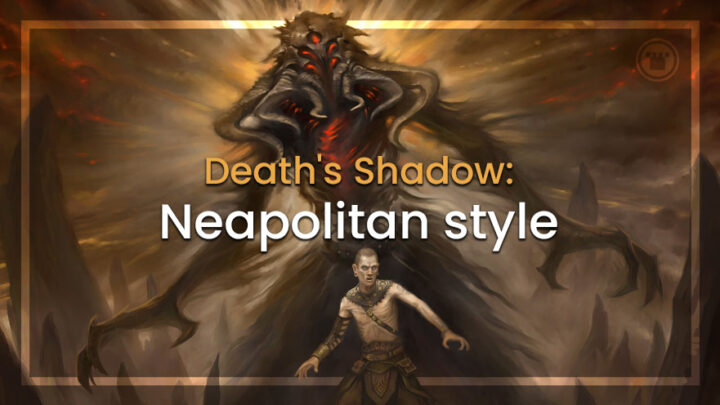Over the last couple of weeks, the Modern metagame has shifted. As certain decks give way to new pieces of tech, others rise to the top. And as new threats find a target on their back, combo decks like Death’s Shadow seem primed to feast.
The initial pebble that caused these ripples is Leyline Binding, which has put pressure on Murktide Regent. This, in turn, has impacted the deck’s matchup spread, making Rhinos (a traditionally positive matchup) more difficult and Four-Color Yorion (a traditionally difficult matchup) even harder.
With Izzet Murktide trending downward, that leaves Four-Color Yorion as the clear deck to beat. With Yorion vulnerable to combo decks when Murktide isn’t as prominent to punish them, Death’s Shadow becomes an attractive choice again.
But isn’t Leyline Binding also good against Death’s Shadow? Well, Leyline Binding is about as good as any removal spell against Death’s Shadow. The reason Murktide struggles with it so much is because Murktide Regent requires a significant resource investment while Death’s Shadow is much easier to enable, especially in multiples.
In addition to Death’s Shadow being better against Leyline Binding, Shadow decks contain more secondary threats than Murktide decks, on average, making it more likely that Shadow decks will have a clock left in play after a Binding comes down.
As evidence of this, I’ve seen three different flavors of Death’s Shadow put up results recently: the classic Grixis version we all know, an explosive Rakdos version and a much more controlling Dimir version. These three decks all approach the metagame from a different angle, and all have their own strengths and weaknesses.
Which version you select should depend on what metagame you expect, so I’ll be taking a deeper look at each of them today.
Grixis
Chances are if you’re familiar with Modern, you’re familiar with Grixis Death’s Shadow — so I’m going to use it as a baseline.
Of the three versions I’ll be talking about today, Grixis is decidedly the most mid-range option. It features some controlling elements, like Spell Pierce, Drown in the Loch and Unholy Heat, to manage the match. The name of the game is to stick an early Ragavan or Dragon’s Rage Channeler and keep the way clear. As you chip your opponent down, you work on building card advantage with Expressive Iteration.
Grixis has the least extreme matchup spread of the three, which is both good and bad. Many of your matches will be close, and you’ll need to maneuver tight situations in order to win games. On the other hand, you’ll have less matchups where you just get completely blown out of the water.
Grixis is the best of the three versions against Four-Color Yorion, given it has a good mixture of pressure and disruption. That makes the list adaptable to whichever game plan your opponents choose. Hammer tends to be best for Grixis as well, thanks to the amount of removal it has — plus Dress Down.
Finally, Rhinos, at least the Temur version, is traditionally a strong matchup for Grixis, propped up by Ledger Shredder being an incredibly good blocker until it turns the corner into offense. Drown in the Loch is also a strong tool to have against cascade decks.
Decks that require you to specialize your interaction toward either counter magic or removal spells while rendering the other ineffective are where Grixis tends to struggle. Creativity is a good example of this, as your removal spells, at best, can act as a quasi counterspell — but only if your opponent goes for a Transmogrify or Indomitable Creativity on one target. Even then, if they target a treasure token, it doesn’t particularly work. Tron is another classic matchup where Grixis struggles, because the removal spells are basically always dead.
Rakdos
Rakdos is easily the most explosive of the three decks here. Scourge of the Skyclaves gives Rakdos a second, large threat in addition to Death’s Shadow to really turn up the heat. In addition, Street Wraith and Temur Battle Rage turbo charge Rakdos Shadow, allowing them to kill out of nowhere.
Simple and streamlined, Rakdos Shadow is trying to go A to B in as little time as possible. Thoughtseize and Fatal Push keep the opponent off balance just long enough for Rakdos Shadow to put them in the ground with huge, must answer creatures.
Temur Battle Rage isn’t quite Drown in the Loch or Spell Pierce against combo decks, but it does give the deck enough speed to finish the game when backed up by Thoughtseize and Inquisition of Kozilek. Notably, Rakdos Shadow gives up cards like Expressive Iteration and Kaito for card advantage. But as they say in the business, you don’t need card advantage if you kill your opponent instead.
One matchup where Temur Battle Rage really shines is against Creativity. Traditionally, it has been tough for Shadow because dwarf tokens do a great job keeping the player who controls them alive. However, they’re much less effective when a Scourge of the Skyclaves tramples over for a huge chunk of damage.
Speaking of the Creativity matchup and other decks that are straining their mana for Leyline Binding, Rakdos Shadow gets to play Blood Moon out of the sideboard to absolutely slam the door on greedy mana bases.
Rakdos is going to struggle with decks that force you to interact on the stack. Burn and Living End are classic examples, as you may not be fast enough to kill them reliably before they kill you. It’s also hard to deter them with this deck. Losing access to Dress Down means most of the decks with Urza’s Saga are also better than normal against Rakdos Shadow, and Elementals is sure to be a tough matchup.
Dimir
Dimir Shadow wants to take the game slower and play a classic, Delver-style game plan of landing a threat and countering everything the opponent does for the rest of the game.
Death’s Shadow teaming up with Murktide Regent is reminiscent of the dynamic duo of Death’s Shadow and Scourge of the Skyclaves. This gives the deck eight huge threats that end the game in short order if left unanswered. The good news is that with 11 main deck counters, it is genuinely hard to answer Death’s Shadow and Murktide Regent.
Dimir Shadow, while wanting to play like a Delver deck, has the best ability to perform as a hard control deck, absolutely locking down an opponent for long periods of time. This means having a pile of counters is incredibly powerful against slower decks with higher average mana costs, like Four-Color Yorion, Scapeshift, Rhinos and Tron.
Burn is also the easiest for Dimir Shadow out of these three builds, as they can take things slow with multiple basic lands, and Murktide Regent backed up by a counterspell or two will make quick work of Burn. Cascade decks are also generally favored with this much counter magic.
The rough matchups are the ones where your opponent can effectively get under your counters. Hammer is the first deck that comes to mind.
This specific build of Dimir Shadow is light on removal spells for creatures already in play if something manages to slip through the cracks. When playing against Hammer, you often want to have a mix of removal and counters, and Hammer demands that your interaction be as cheap as possible. That’s something Dimir is going to struggle a bit with.
Notably, this version is weak against Teferi, Time Raveler, but it has plenty of plenty of ways to keep it off the table. Just be wary of those play patterns.
End Step
It makes me happy seeing Shadow do well in a variety of forms, and there is truly quite a bit of customization available in the archetype depending on what part of the meta you want to target. Even within each flavor, you can move some cards around to further target specific threats.
It’ll be interesting to see how the Modern metagame continues to evolve over the next few weeks, and I’ll be keeping a close eye on how things shake out. As always you can find me on Twitter @RappaciousOne for questions, comments and feedback. I’ll catch everyone back here next week!

Michael Rapp is a Modern specialist who favors Thoughtseize decks. Magic sates his desire for competition and constant improvement.

